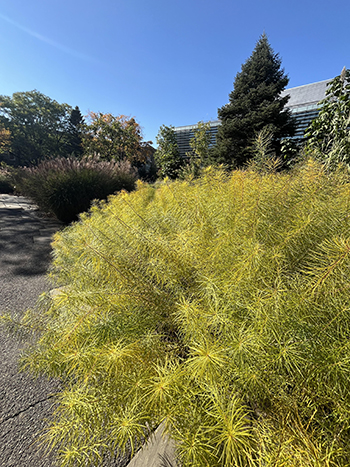
Plants of the Week: October 21
Guest Author: Seamus Lewin, 2024 -2025 Public Horticulture Intern

Anemone x hybrida ‘Honorine Jobert’ (Japanese anemone)
Lining both sides of the iconic Magill Walk are beds full of bright white flowers known as Anemone x hybrida ‘Honorine Jobert’, or Japanese anemone. The dark green foliage, and bright white flowers give this plant a wonderful contrast that make it easy to enjoy and hard to ignore.
Anemone x hybrida ‘Honorine Jobert’ is a vigorous, low maintenance herbaceous perennial that blooms for 5-8 weeks in the late summer to early fall. This cultivar is great for planting at the front of beds as their mound of foliage is low, while the long skyward-reaching wiry flowering stems are easy to see through. I recommend combining this Japanese anemone with spring bulbs and summer blooming perennials to have interest in your garden that spans the entire growing season. Additionally, this cultivar of Japanese anemone makes for a wonderful cut flower.

Muhlenbergia capillaris (muhly grass)
Situated at the entrance to the Harry Wood Garden is a cluster of strikingly pink grasses that looks like something out of a Dr. Suess book. These native grasses, Muhlenbergia capillaris, are commonly known as muhly grass. For most of the year muhly grass forms mounds with erect, bluish green foliage; however, in early fall billowing pink seed heads form a crown akin to cotton candy.
This plant is highly sought after for its undemanding nature, little to no insect or disease pests, and high resistance to deer grazing. As a result of these qualities it is used extensively on highway medians, golf courses, and in home landscapes. Muhlenbergia capillaris can be very showy by itself, but it really shines when used in a mass planting. If you plan to have this grass in your garden, make sure to give it plenty of sunshine and transplant it into well-drained soil. It is quite adaptable to poor soil, and will not require much care after planting.

Amsonia hubrichtii (thread-leaf bluestar)
If you find yourself in the John W. Nason Garden, you may wonder why the plant selection differs from that of a typical garden. This is because the John W. Nason Garden is what’s known as a texture garden. The mission of a texture garden is to provide interest with varying foliage textures and plant heights, rather than vibrant colors and droves of flowering plants. Amsonia hubrichtii is the perfect plant to highlight for accomplishing the mission of a texture garden.
Amsonia hubrichtii has an upright growth habit and will grow in clumps that reach around 4 feet tall. The green leaves, which turn a beautiful golden yellow in the fall, appear tough and spiky but are actually quite soft. This plant is wonderful for making a texture statement in your garden, and blends nicely with taller plants or plants with a softer looking foliage. Be patient with this plant, as the first year of growth for this plant may be drooping and less dense. In the subsequent years, Amsionia hubrichtii will exhibit its upright growth habit.





No Comments